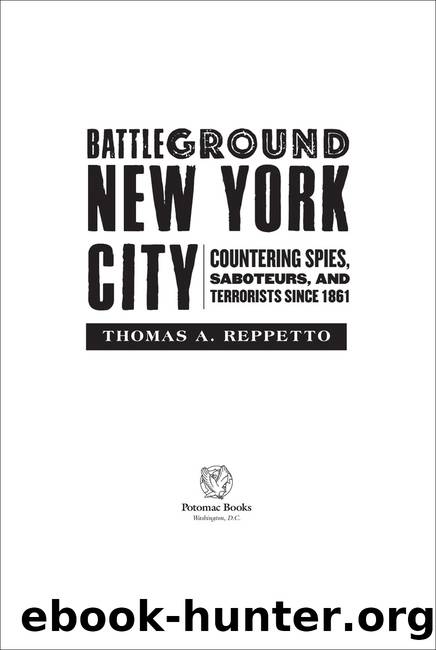Battleground New York City by Thomas A. Reppetto

Author:Thomas A. Reppetto
Language: eng
Format: epub
Publisher: Potomac Books, Inc.
Published: 2012-01-15T00:00:00+00:00
In 1940â1941, several spy rings and a sabotage crew were operating in New York. The latter group was a bit too much for German foreign minister Joachim von Ribbentropâs diplomats. In February 1940, when two Germans came to Dr. Hans Thomson, chargé dâaffaires at the German embassy in Washington, and announced that they were Abwehr saboteurs in need of funds, he panicked. Thomson sent off a message to Abwehr headquarters in Berlin, which denied knowing anything about the men. When Thomson confronted the would-be saboteurs with the denial, they provided details about their training and the names of their superior officers. After more exchanges of information, the Abwehr remembered that it had sent these men to New York, but only as âobservers.â Translated, it meant they were scouting targets, such as New York Harbor, bridges, and transportation facilities. After protests by Ribbentrop, the Abwehr ordered its crew to stand down.
Another Abwehr ring, controlled by Major Ritter, who had stolen the Norden bombsight, was spearheaded by Col. Frederick Joubert âFritzâ Duquesne. A distinguished-looking man in his late fifties, known as the Old Boer, Duquesne claimed that as a boy living in South Africa during the Boer War he had witnessed his mother tortured and killed by the British. Supposedly, this caused him to devote his life to working against them. During World War I he was a German spy in both Britain and the United States. Duquesne was a productive agent, but like Guenther Gustave Rumrich, he was given to wild schemes. Duquesne was the man who had asked to be allowed to kill President Roosevelt by planting a bomb inside a church the president attended near his home in Hyde Park, New York.
Duquesne moved among a higher class of people than the Gestapo thugs or Abwehr saboteurs. He took up with a non-German businesswoman, who helped him in contacting U.S. corporations to obtain information on products of interest to the Germans. In 1941 she moved into his apartment on West Seventy-Fourth Street, off Central Park. Other members of Ritterâs organization included a courtesan, Lilly Stein. The former Viennese model, who operated out of an Upper East Side apartment, was not the blonde beauty of spy fiction. Her figure had sagged and her face had become haggard since her Viennese days. Steinâs services to Duquesne were basically as a courier. Another member of the ring was Herman Lang, not yet suspected of having stolen the Norden bombsight.
Ohio-born Kurt Ludwig, the agent who had tried to retrieve Ostenâs luggage at the Taft, had been brought up in Germany. When the war started, he was trained as an Abwehr spy. A nondescript little man, he arrived in the United States in 1940 and quickly acquired a seventeen-year-old assistant named Lucy Boehmler. Lucy had come to the United States with her German parents when she was five, was raised on Long Island, and attended high school in Queens. Though her parents were anti-Nazis, she was attracted to mystery men.
As America began to raise an army, Ludwig was ordered to make a survey of U.
Download
This site does not store any files on its server. We only index and link to content provided by other sites. Please contact the content providers to delete copyright contents if any and email us, we'll remove relevant links or contents immediately.
| Espionage | Hoaxes & Deceptions |
| Murder & Mayhem | Organized Crime |
| Serial Killers | White Collar Crime |
Mindhunter: Inside the FBI's Elite Serial Crime Unit by John E. Douglas & Mark Olshaker(9260)
Wiseguy by Nicholas Pileggi(5707)
Room 212 by Kate Stewart(5070)
Hitman by Howie Carr(5041)
Secrecy World by Jake Bernstein(4698)
Killers of the Flower Moon: The Osage Murders and the Birth of the FBI by David Grann(4407)
Papillon (English) by Henri Charrière(4223)
Breaking Free by Rachel Jeffs(4195)
Killers of the Flower Moon by David Grann(3996)
Say Nothing by Patrick Radden Keefe(3937)
American Kingpin by Nick Bilton(3816)
The Secret Barrister by The Secret Barrister(3661)
Molly's Game: From Hollywood's Elite to Wall Street's Billionaire Boys Club, My High-Stakes Adventure in the World of Underground Poker by Molly Bloom(3508)
Mysteries by Colin Wilson(3420)
In Cold Blood by Truman Capote(3344)
Signature in the Cell: DNA and the Evidence for Intelligent Design by Stephen C. Meyer(3098)
I'll Be Gone in the Dark by Michelle McNamara(3054)
Rogue Trader by Leeson Nick(3008)
Bunk by Kevin Young(2970)
